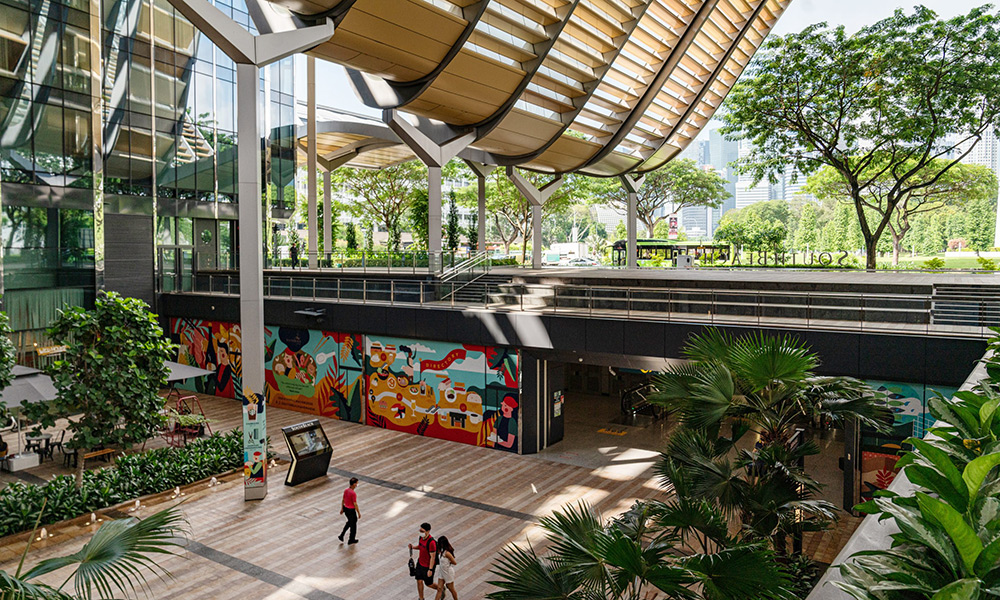解决气候变化问题,可以从亚洲房地产入手

亚洲正处于气候危机第一线。在受洪水和极端天气威胁最严重的15个国家中,有10个位于亚洲。这就是为什么在谈到亚洲房地产和气候变化时,我们经常谈到弹性。如何保护建筑物免受不断上涨的海水、破坏性极强的风暴乃至高温的影响?
但我们可能忽略了将建筑本身当成问题的根源。每年40%的碳排放来自房地产,即使对了解可持续性的人们来说,这一数字也让人瞠目。
建筑在改变气候方面的巨大作用应该敲响警钟。负责建造、经营和维护建筑的房地产公司如果想减少对气候的影响,能发挥什么作用?
对商界领袖和全球决策者来说,联合国政府间气候变化专门委员会(Intergovernmental Panel on Climate Change)的报告敲响一记警钟,报告中强调了建筑和经营产生的碳排放。建筑过程中以及用于加热、冷却和照明建筑物的能源都会产生碳排放。随着全球建筑存量翻一番,从现在到2050年,建筑材料本身的碳排放量将占房地产碳足迹总量的近一半。
渴望改变
企业和公众利益团体越发关注房地产投资组合对环境的影响。事实上,有数据显示,83%的房地产使用者和78%的投资者接受了气候造成金融风险的概念。
在政府间气候变化专门委员会的报告发布后,全球各地对可持续性的审查不断加强,促使执行计划不够积极的公司推进变革。五分之一的企业所有者在可持续发展曲线上遥遥领先。最终,这些领导者将推动可持续发展议程,而其他人则要迎头赶上。
由于担心气候变化造成的金融风险,投资者也对企业达到新道德标准施加压力,到2025年,亚太地区实现净零碳承诺的公司数量将增加一倍。连普通员工也在推动趋势,70%的受访员工认为,可持续发展计划是当今企业必须选择的道路。
然而,如果不重点关注建筑环境,企业乃至国家对净零排放的承诺就无法真正实现。以可持续方式改造建筑也能够为业主、投资者和使用者直接创造价值。
价值增加可能来自不太受关注的地方。我们发现,80%的员工希望在有植物和户外空间的建筑物,比如有屋顶花园的大楼中工作。因此,支持可持续性的努力将在员工效率和留任率方面产生回报。
找出变革的障碍
如果企业在可持续性方面处于领先地位,最终将为绿色投资、租赁和运营制定标准,其他方面只能遵循标准。然而当前只有五分之一的企业有明确的可持续发展目标,脱碳是房地产战略的关键。
很多企业向可持续发展迈进面临内部障碍,例如管理层脱节、可持续发展战略与当前业务目标错位、面对紧迫的企业需求而放弃优先向可持续发展投资,以及缺乏利益相关方问责制等等。
企业面临的外部障碍可能更难解决,比如受基础设施老化局限,或者无法获得智能建筑和能源监测等最新技术和数据。
实施各项措施需要企业、业主、投资者和政府之间密切公私合作。幸运的是,合作方式得到了强有力支持。90%的使用者认同,城市、投资者、开发商和使用者之间加强合作有助于实现建筑环境净零排放的目标。
推进进展如何?太古地产(Swire Properties)提供免费能源审计,帮助中国香港和内地租户了解使用模式并寻找节能机会,从而吸引租户参与其中。新加坡的环境激励措施包括能源效率基金(Energy Efficiency Fund),主要为企业提供资金以提高设施的能源效率,最高可达成本的50%。种种举措显示了多方利益相关者加强合作以推动可持续行动的价值和重要性。
但底线是:房地产在帮助企业实现可持续发展目标方面可以且必须发挥关键作用。无论是在企业与员工、业主与租户之间,还是在公共部门与私营部门之间,房地产都能够在推动建立更可持续经济所需的重要关系方面发挥关键作用。
当前房地产既是气候危机的原因,也是受害方。换个角度看,房地产可能也是解决问题的关键。(财富中文网)
卡米亚·米格拉尼是仲量联行(Jones Lang LaSalle)亚太区企业解决方案研究董事。
译者:冯丰
审校:夏林
亚洲正处于气候危机第一线。在受洪水和极端天气威胁最严重的15个国家中,有10个位于亚洲。这就是为什么在谈到亚洲房地产和气候变化时,我们经常谈到弹性。如何保护建筑物免受不断上涨的海水、破坏性极强的风暴乃至高温的影响?
但我们可能忽略了将建筑本身当成问题的根源。每年40%的碳排放来自房地产,即使对了解可持续性的人们来说,这一数字也让人瞠目。
建筑在改变气候方面的巨大作用应该敲响警钟。负责建造、经营和维护建筑的房地产公司如果想减少对气候的影响,能发挥什么作用?
对商界领袖和全球决策者来说,联合国政府间气候变化专门委员会(Intergovernmental Panel on Climate Change)的报告敲响一记警钟,报告中强调了建筑和经营产生的碳排放。建筑过程中以及用于加热、冷却和照明建筑物的能源都会产生碳排放。随着全球建筑存量翻一番,从现在到2050年,建筑材料本身的碳排放量将占房地产碳足迹总量的近一半。
渴望改变
企业和公众利益团体越发关注房地产投资组合对环境的影响。事实上,有数据显示,83%的房地产使用者和78%的投资者接受了气候造成金融风险的概念。
在政府间气候变化专门委员会的报告发布后,全球各地对可持续性的审查不断加强,促使执行计划不够积极的公司推进变革。五分之一的企业所有者在可持续发展曲线上遥遥领先。最终,这些领导者将推动可持续发展议程,而其他人则要迎头赶上。
由于担心气候变化造成的金融风险,投资者也对企业达到新道德标准施加压力,到2025年,亚太地区实现净零碳承诺的公司数量将增加一倍。连普通员工也在推动趋势,70%的受访员工认为,可持续发展计划是当今企业必须选择的道路。
然而,如果不重点关注建筑环境,企业乃至国家对净零排放的承诺就无法真正实现。以可持续方式改造建筑也能够为业主、投资者和使用者直接创造价值。
价值增加可能来自不太受关注的地方。我们发现,80%的员工希望在有植物和户外空间的建筑物,比如有屋顶花园的大楼中工作。因此,支持可持续性的努力将在员工效率和留任率方面产生回报。
找出变革的障碍
如果企业在可持续性方面处于领先地位,最终将为绿色投资、租赁和运营制定标准,其他方面只能遵循标准。然而当前只有五分之一的企业有明确的可持续发展目标,脱碳是房地产战略的关键。
很多企业向可持续发展迈进面临内部障碍,例如管理层脱节、可持续发展战略与当前业务目标错位、面对紧迫的企业需求而放弃优先向可持续发展投资,以及缺乏利益相关方问责制等等。
企业面临的外部障碍可能更难解决,比如受基础设施老化局限,或者无法获得智能建筑和能源监测等最新技术和数据。
实施各项措施需要企业、业主、投资者和政府之间密切公私合作。幸运的是,合作方式得到了强有力支持。90%的使用者认同,城市、投资者、开发商和使用者之间加强合作有助于实现建筑环境净零排放的目标。
推进进展如何?太古地产(Swire Properties)提供免费能源审计,帮助中国香港和内地租户了解使用模式并寻找节能机会,从而吸引租户参与其中。新加坡的环境激励措施包括能源效率基金(Energy Efficiency Fund),主要为企业提供资金以提高设施的能源效率,最高可达成本的50%。种种举措显示了多方利益相关者加强合作以推动可持续行动的价值和重要性。
但底线是:房地产在帮助企业实现可持续发展目标方面可以且必须发挥关键作用。无论是在企业与员工、业主与租户之间,还是在公共部门与私营部门之间,房地产都能够在推动建立更可持续经济所需的重要关系方面发挥关键作用。
当前房地产既是气候危机的原因,也是受害方。换个角度看,房地产可能也是解决问题的关键。(财富中文网)
卡米亚·米格拉尼是仲量联行(Jones Lang LaSalle)亚太区企业解决方案研究董事。
译者:冯丰
审校:夏林
Asia is on the front line of the climate crisis: 10 of the 15 nations most at risk from flooding and extreme weather are based in Asia. That can be why, when it comes to talking about Asian real estate and climate change, we often talk about resilience. How do we protect buildings from rising waters, hugely damaging storms, or even just high temperatures?
But we can miss thinking about buildings as a cause of the problem themselves: 40% of annual carbon emissions comes from real estate which—even for those in the know about sustainability—is an eye-popping statistic.
Alarm bells should be ringing over the large role our buildings play in changing our climate. But what role can real estate companies—the ones responsible for constructing, operating, and maintaining these buildings—play in reducing that role?
The Intergovernmental Panel on Climate Change’s report was a rude awakening for business leaders and global policymakers, highlighting the carbon emissions generated by the construction and operation of buildings. Emissions are released during construction, and from the energy used to heat, cool, and light up buildings. Then you have the emissions released from making the building materials themselves—which will make up almost half of the entire carbon footprint for real estate between now and 2050 as the global building stock doubles in size.
A desire for change
Business and public stakeholders are increasingly paying attention to the environmental impact of their real estate portfolio. In fact, according to our data, 83% of real estate occupiers and 78% of investors in the survey accept that climate poses a financial risk.
Driven by heightened global scrutiny around sustainability after the IPCC report, companies that were perhaps less-than-diligent in their plans are being pushed to change. One-fifth of corporate occupiers are significantly ahead on the sustainability maturity curve—these leaders will end up driving the sustainability agenda, leaving the rest to catch up.
The number of companies in Asia-Pacific that will adopt a net-zero carbon commitment is set to double by 2025, driven by concerns over the financial risk from climate change and investor pressure to meet new ethical standards. Even employees are part of the trend: Seven in 10 workers polled believe that sustainability initiatives are a must for today’s businesses.
Yet corporate, and even national, commitments to net zero cannot be meaningfully achieved without a focus on the built environment. And, in fact, adapting buildings in sustainable ways would also create upfront value for landlords, investors, and occupiers alike.
That increased value may come from unlikely places: We found that 80% of workers want to be in buildings with plants and outdoor spaces, like rooftop gardens. Thus, efforts to bolster sustainability will have a payoff in employee productivity and retention.
Identifying barriers to change
Those that lead the way on sustainability will end up setting the standards for green investment, leasing, and operations that everyone else will end up following. Yet only one in five businesses has well-defined sustainability goals, with decarbonization as a key part of its real estate strategy.
Yet many businesses face internal barriers that impede their progress toward sustainability, such as a disengaged executive leadership, misalignment between sustainability strategy and current business objectives, deprioritized sustainability investments in the face of urgent organizational needs, and a lack of stakeholder accountability.
Businesses also face external hurdles that may be tougher to address, such as being tied to a space with aging infrastructure, or that lacks access to the newest technology and data—such as smart buildings and energy monitoring.
But implementing these measures will require close private-public collaboration between businesses, their landlords, investors, and the government. Fortunately, there’s strong support for a collaborative approach: 90% of occupiers agree that collaboration between cities, investors, developers, and occupiers will be instrumental in achieving the net-zero ambitions of the built environment.
So what are people doing now? Swire Properties is engaging tenants in Hong Kong and mainland China by offering free energy audits to help them understand their usage patterns and identify energy-saving opportunities. Singapore’s incentives for the environment include an Energy Efficiency Fund (E2F), which provides funding for businesses to improve the energy efficiency of facilities for up to 50% of the qualifying costs. These initiatives demonstrate the value and importance of multi-stakeholder collaboration to move the needle on sustainable action.
But here’s the bottom line: Real estate can and must play a critical role in helping businesses turn their sustainability ambitions into reality. They can be a key enabler in building the important relationships needed to create a more sustainable economy, whether between business and employees, owners and tenants, or between the public and private sectors.
Real estate is currently both a cause and a victim of our current climate crisis. But it can be a key part of the solution as well.
Kamya Miglani is director of research, work dynamics, APAC at Jones Lang LaSalle.













